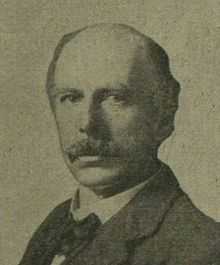Thomas Bateman Napier

His Hon. Thomas Bateman Napier LLD (1854-6 November 1933), was a British Liberal Party politician and judge.
Family
He was a son of Richard Clay Napier of Preston, and Sarah Bateman of Salford. He was educated at Rugby School and London University. He married first in 1882, Florence Emily Roberts of Upminster, who died in 1915. They had one son who was killed in the Great War, and two daughters. He married second in 1917, Mrs Amy Julia Tootal who died in 1923.[1]
Legal career
During his student days he gained the Incorporated Law Society’s Clifford Inn Prize, and Scot. Scholarship, and the Council of Legal Educated’s first class International and Roman Law Exhibition, and other law scholarships and prizes. He took a first class in Law at the University of London; honours at Bar Call. Examination. He was elected Fellow and Member of Senate, University of London, in 1895. He became a Justice of the Peace in Middlesex, 1895. He wrote a Concise Practice of the Supreme Court of Justice; The New Land Taxes, 1909–1910. He became Judge of County Courts, in Derbyshire, in 1912.[2]
Political career
He was a Member of the London County Council from 1893–1906.[3] He contested Islington North as a Liberal candidate in 1895. He was twice Chairman of Corporate Property, and three times Chairman of Parliamentary Committee, of the London County Council. He sat as Liberal MP for the Faversham Division of Kent from 1906–10. He had gained the seat from the Conservatives at the 1906 General Election
| General Election 1906
Electorate 14,860 | |||||
|---|---|---|---|---|---|
| Party | Candidate | Votes | % | ±% | |
| Liberal | Thomas Bateman Napier | 6,925 | 57.6 | n/a | |
| Conservative | John Howard | 5,091 | 42.4 | n/a | |
| Majority | 1,834 | 15.2 | n/a | ||
| Turnout | n/a | ||||
| Liberal gain from Conservative | Swing | n/a | |||
but lost it back to them at the next General Election in January 1910.
| General Election January 1910
Electorate 14,649 | |||||
|---|---|---|---|---|---|
| Party | Candidate | Votes | % | ±% | |
| Conservative | Granville Charles Hastings Wheler | 7,438 | 58.0 | +15.6 | |
| Liberal | Thomas Bateman Napier | 5,394 | 42.0 | -15.6 | |
| Majority | 2,044 | 16.0 | 31.2 | ||
| Turnout | 87.6 | ||||
| Conservative gain from Liberal | Swing | +15.6 | |||
He did not stand for parliament again.[4] He was a co-opted Member of the London Educated Committee, 1915. He became a Governor of Rugby School, in 1927.[5]
Sources
- Who Was Who
- British parliamentary election results 1885-1918, Craig, F. W. S.
References
External links
- Who Was Who; http://www.ukwhoswho.com
| Parliament of the United Kingdom | ||
|---|---|---|
| Preceded by John Howard |
Member of Parliament for Faversham 1906–January 1910 |
Succeeded by Granville Wheler |
]